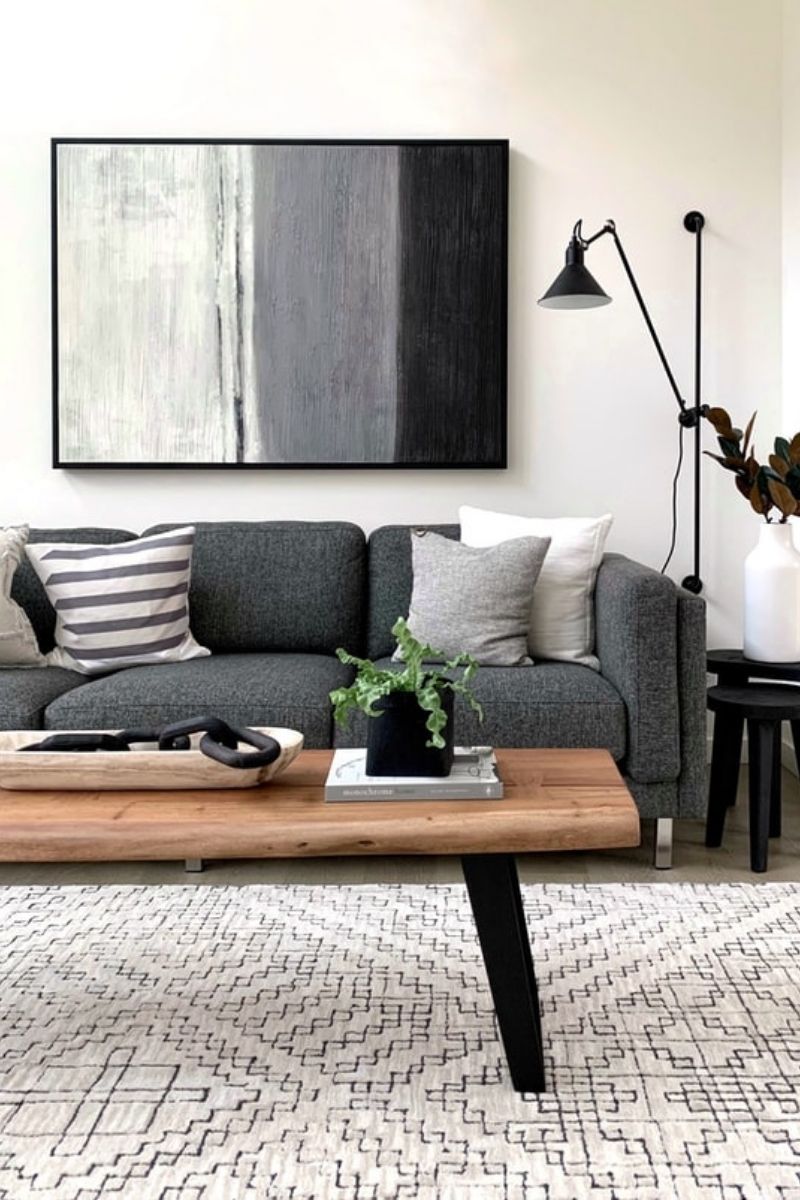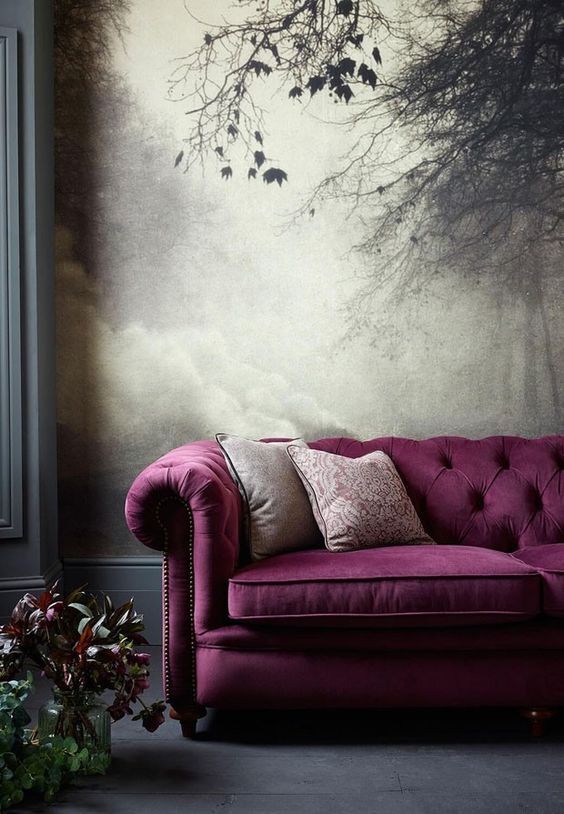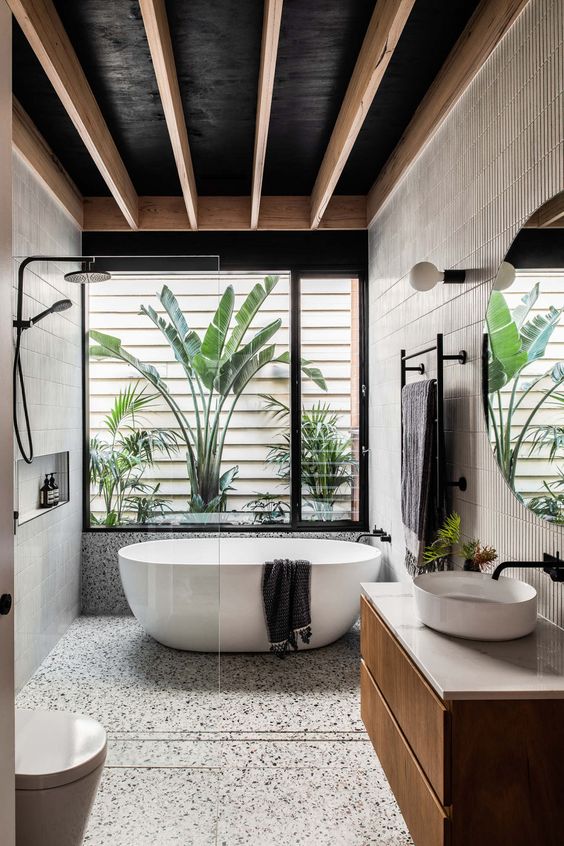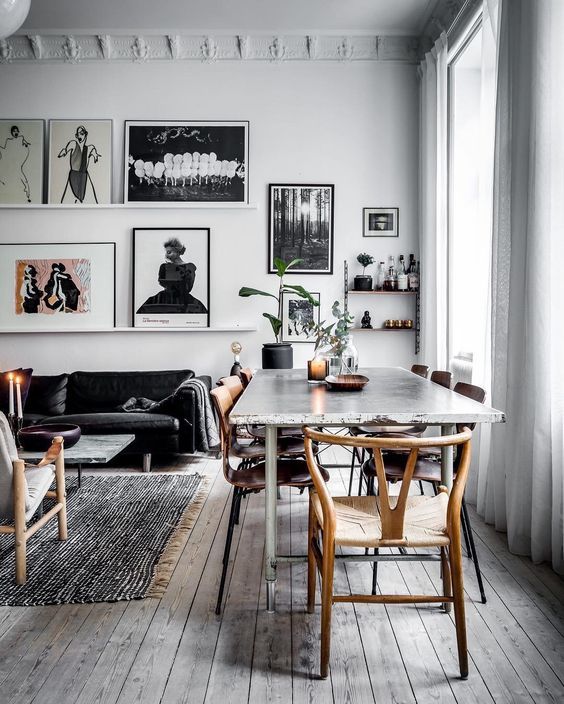How To Choose An Area Rug (The Right One!)
How to choose an area rug? Choosing the right area rug for your room can be a long process!
But it’s an important element to decide on. One of the most common design mistakes is choosing your area rug last. Choosing your area rug early in your design process can help you decide on other factors that will help you in designing your room. The rug is a great focal point in any room and the size, color, shape and texture will inform other decisions on your room. Things like the color for your walls and your furniture layout.
The main rule of thumb to remember when choosing an area rug is to buy the largest size you can afford. But not an area rug so big that it takes up the whole of your floor space. Follow the tips below to find out the best way to choose your rug.
How To Choose An Area Rug
How To Choose The Right Rug Size
- Leave at least 8 inches (20cm) and up to a maximum of 24 inches or 2 feet (60cm) between the rug and your walls.
- Use a tape measure and measure your room wall to wall. This will determine how large or small a rug you can choose.
- There are lots of different rug sizes but standard rug sizes are; 2’x3′, 4’x6′, 5’x7′, 6’x9′, 8’x10′, 9’x12′, 10’x14′. You can get a custom rug size as well for a larger room.
Choosing Area Rugs For The Living Room
An area rug needs to be large enough so you can fit all the furniture on the rug. If the rug is just “floating” in the middle of the room sitting underneath the coffee table it’s too small.
The rug is used to define areas of zones of spaces. One zone would be the sitting area. The coffee table, sofa and accent chairs would be included in the seating area. If you can’t fit all these pieces fully on the rug then the front legs of the sofa and chairs should at least be on the rug.
The rug should extend beyond the length of the sofa. So the seating arrangement doesn’t look like it’s squashed to fit onto the rug. The sizing proportions need to make sense. Getting the right size rug is important to getting the look right for the room.
The bigger your seating arrangement the larger your area rug needs to be. When you have all your furniture on the rug it makes the living room seem larger than it is.
Best options: Wool, acrylic, polypropylene, sisal, jute.

Choosing Area Rugs For Bedroom
How to choose an area rug for your bedroom?
For a bedroom, the size of the bed is going to help you determine the size of the area rug.
If you have a queen-sized bed the minimum size rug you need is 6×9′. Apply the same rules for spacing between the wall and the rug as you would do in the living room area.
You should aim to place the area rug at least two-thirds under your bed with a good landing space on either side of the bed. Solid colors for rugs or patterned rugs, it’s totally up to you. Or you can do both, layering rugs in the bedroom can cozy the space up and add interest and texture to your bedroom.
Rug Sizes for Bed
- Double Bed – 6’x9′ rug
- Queen Bed – 6’x9′ or 8’x10′ rug
- King Bed – 8’x10′ or 9’x12′ rug
Best options: Anything goes! You can afford to go for more luxurious and high-pile rugs as the bedroom is considered a low-traffic area.
However, if your bedroom door is close to your bed and opens over your rug low-pile rugs are the better option. Unless you don’t mind cutting the bottom of your door for it to open and close easily.

Area Rugs Dining Room
If you choose to have an area rug underneath your dining table make sure the style is suitable for the area. Having a white or light-colored rug under your dining table isn’t practical. Food is bound to fall onto the rug at some point.
Outdoor rugs are a great option if you want a light-colored area rug. Plus an outdoor rug is easy to clean and maintain.
Also, make sure that the size of the rug accommodates when the chairs are pulled out from the table. The chairs still should have a rug landing underneath them. A general rule of thumb is to allow an extra 36 inches of rug allowance so your chairs sit on the area rug when pulled out from the table.
If your dining chairs have castor wheels, then a durable and low pile rug is a must. Low pile and flatweave rugs minimize wear and tear from the wheels.
Best options: Flat weave, low pile rugs, dark colored rugs, patterned, sisal, jute, seagrass and outdoor rugs.

Open Floor Plan
For an open-floor home, rugs are the perfect way of zoning areas and making a small space according to the need. Use a tape measure to zone out your different areas and leave at least 3 feet between each zone for walkways.
The rugs for this type of space don’t have to match but they should complement each other. You can do this with choosing a color tone, a similar pattern or style.
High-Traffic Areas
For high-traffic areas in the home like entryways and hallways, and small bathrooms low-pile rugs are the best rugs to have in those areas. Low-pile rugs will handle the wear and tear of people coming and going over the long term. Patterned rugs are great at hiding dirt and stains.
Hallways and walkways tend to be narrower so rug runners are the best option for these areas.
Layering Rugs
Don’t think that if you have carpet you can’t use an area rug. Even if you have carpet in some rooms you can add a rug on top.
It will give the room an extra cozy feeling. If the carpet you have is a neutral colour bringing in an area rug is a chance to add some interest with a pop of colour, an exciting print or a pretty pattern.
RELATED POST: 5 Easy Tips To Layering Rugs In The Living Room
You can also layer a smaller rug on top of a larger one and play around with color and texture. Starting with a neutral colour base is easier and a lower pile is easier to work from.

Different Types Of Area Rugs
Low Pile & Flat Weave
Low pile and flat weave area rugs are the options you want to look for if you need something durable and hard-wearing. Especially if that area is going to get a lot of footfall. They’re easier to clean and low maintenance. If you’re considering the layered rug look then start with a low pile or a flat weave rug.
High Pile Rugs
High-pile rugs are looser and have longer strands and loops. They’re more luxurious and softer but can be difficult to maintain. It’s better to keep these kinds of rugs in low-traffic areas such as the bedroom.
Machine-Washable Rugs
Anyone with a busy family knows what a lifesaver a washable rug can be. And this is the reason why more companies like Ruggable and Boutique Rugs have rug collections that are machine washable.
Handknotted Rugs
The construction and how it’s made can also push the cost up. Hand-knotted rugs made from natural fibers are a good example of this.
As it’s handmade a lot of time and effort goes into just making one rug. But hand-knotted rugs can last a long time depending on where the rug is placed. Persian rugs are known for being of good quality and make a great statement piece. And last for years.
Natural Area Rug Type Materials
Different textures give different moods to spaces as well as how the rugs feel underfoot. For soft and cozy rugs made from natural fibers tend to be a good choice.
These rugs are great if anyone in your family has allergies. Because of their natural fibers these rugs can cost more than synthetic rugs because they tend to last longer.
Wool Rugs:
Wool is usually considered one of the best options if you’re looking for a durable yet soft rug. When buying a wool rug, the price can vary dramatically due to the size of the rug and the quality of the wool.
Wool is a renewable and sustainable fiber and it will last a long time. Which is why wool is usually considered the best option.
Cotton Rugs:
Cotton rugs are soft but can be less durable than other natural materials it usually comes in a flat weave design. It is usually blended with wool to make it a bit more durable.
Cotton can be more reasonably priced than wool rugs. And some cotton rugs you can even toss in the washing machine. A cotton rug might be ideal for a nursery or children’s room.
Silk Rugs:
Silk is a delicate fiber and is not good in high-traffic areas. It is often blended with wool to give it a different look and to keep the price affordable as 100% silk rugs are expensive. Silk tends to get dirtier quickly and is difficult to clean.
Jute Rugs:
Jute is a plant-based fiber great for high-traffic areas for its durability qualities and comes in a range of textures and weaves. Although it is made of natural fibres from jute grass it is softer than other natural options like sisal and seagrass.
Sisal Rugs:
Sisal is another great option for high-traffic areas like the hallway. It’s durable and strong but it is a coarser material than jute. However, do not soak with water to clean as it can stain and cause the fibres to expand.
RELATED POST: The Best Natural Rugs (Guide To Natural Fibre Rugs)
Seagrass Rugs:
Seagrass is another eco-friendly option that is stain-resistant and repels liquids. Highly durable so good for high-traffic areas and comes in a variety of different weaves. However, seagrass rugs tend to be more expensive than jute.
Animal Hides:
Animal hides are durable and easy to clean and last for years. They offer interest in the unique shapes available, their color and markings. Hides are on the thin side so it might be best to layer on top of a textured rug like a sisal or a seagrass. You can layer hides on top of flatweave rug too.
Synthetic Area Rug Materials
Acrylic Rugs:
A popular alternative to a wool rug. With acrylic rugs, you can get similar designs as what you would find to wool. Acrylic area rugs are cheaper, easier to clean and still very durable.
Polypropylene Rugs:
A good synthetic alternative to a wool rug although it doesn’t feel as nice as wool. It is extremely durable and stain resistant, easy to clean. Outdoor rugs are usually made of polypropylene.
Viscose Rugs:
This material has a high sheen and soft finish to the rugs. It’s usually too delicate for high-traffic areas even when blended with wool. Any spillages even just with plain water and it tends to stain. On the positive side, viscose is very soft and has luxurious look about it so this type of rug is perfect for the bedroom.
Outdoor Rugs
An outdoor rug can be used inside the home too. They’re a popular option for most rooms due to their durability and maintenance because they’re usually made from synthetic fibers.
The Shape Of Your Rug
Ideally, you want to match the shape of your rug to the furniture arrangement. A round rug wouldn’t look great under a rectangular sofa or table. Rectangular rugs tend to look best under linear furniture and round rugs with curved furniture and round tables.
Unless your layering rugs stick with the shape of your furniture for your rugs. A round table, use a round rug. A square table, use a square rug. With an oval table dining table you can use a rectangular rug or a round rug. As long as the rug is big enough to sit all the chairs on it.
Rug Color?
The color of your rug comes down to personal preference and what kind of mood you’d like to create in your room. Solid colors in neutral tones are always popular as the colors work well with different design styles.
Adding a patterned rug is a great way to make a focal point in the space if you’d rather your rug stand out. Picking your rug first is a great way to help with choosing the colors for the rest of your room.
Top Tips For Area Rugs
- Remember that area rugs will shed and the natural fiber rugs will tend to shed more than the synthetics.
- It’s always best to buy a rug pad for under the rug. This helps to protect your flooring from heavy furniture, it stops the rug from slipping about and will help the rug last longer.
- If you have a working or open fireplace it’s better to opt for a natural fiber rug as they are less flammable than synthetic rugs.
- Rugs placed in direct sunlight need to be rotated to avoid fading or choose a synthetic rug to minimize fading.
Use your rug to make a statement, to bring in some color or simply to bring the rest of the room together. Whatever option you have or choose make sure it works in terms of function for yourself and your family.
Companies to Shop Rugs Online
- Amazon
- Anthropologie
- Burrow
- Boutique Rugs
- CB2
- Crate & Barrel
- Lulu & Georgia
- McGee & Co.
- Overstock
- Revival Rugs
- Ruggable
- Rugs Direct
- Rug Studio
- Rugs USA
- Serena & Lily
- Wayfair
- World Market
I hope these tips on how to choose an area rug have helped you! Remember to choose a rug that works best for your lifestyle first and work from there.
Chloe

This post contains some affiliate links which I may make a small commission from should you purchase something. For more information check out the disclosure and terms and conditions page.
- 7 Best Tips For Lighting Over Round Dining Table
- 12 Easy Ways To Refresh Your Home For Spring
- Beautiful Woven Basket Wall Decor To Fill A Blank Space
- How To Choose An Area Rug (The Right One!)
- Guide How To Design A Kid-Friendly Living Room






